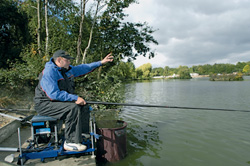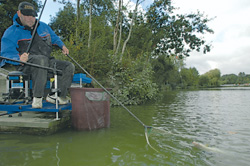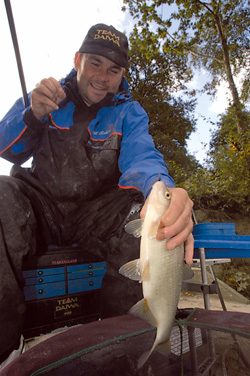Many commercials now allow bloodworm and joker in the colder months, however it’s not the time to abandon your maggot. Will Raison knows that feeding a maggot line can still be the way to a frame place, even in the depths of winter…
Maggots are one of my all time favourite baits and while I love bloodworm and joker fishing, you won’t catch me without some white and red maggot in winter. Most people who know me, know I love nothing more than fishing for roach in winter with bloodworm and joker, but maggot are just as important an element in a winter match on venues like Gold Valley and similar waters across the country.
The reason is, that the big roach in these waters can be encouraged to feed at fairly short range by simply loose feeding maggot. When the roach switch onto them, they do so with a vengeance and you can catch some big weights.
I’ve seen this approach rip matches apart and 30lb to 40lb nets are not uncommon – and that’s in winter. We are mostly talking roach but you will also catch hybrids, some rudd and you can also pick up the occasional big skimmer, bream and carp. In the really cold depths of winter, big perch also come into the equation.
In the early part of the bloodworm season, the worm is very good for a spell, but when the temperatures start to warm up again, after a freeze for example, the bigger roach seem to prefer maggot. In most situations a bloodworm and joker line is fished long, around 11 and 12 metres, so the ideal place for a maggot line is between five and six metres, which distinctly separates the two swims.
Steady Feeding
 |
| Regular loose feeding is the key to catching short. |
I would still look to start on the bloodworm and joker long pole approach, but the maggot line is fed steadily from the off.
One of the advantages is that being a close line it is very easy to feed by hand while fishing further out on the long pole. You can flick a few maggots over it at regular intervals without having to interrupt your long pole work and it’s this regularity of the loose feed that is the key to the lines’ success or failure.
Another advantage of the short distance is, that once the fish arrive, you will catch much quicker than if you were fishing longer. Another reason that five or six metres is a good distance on commercial waters is because a lot of pleasure anglers throw their bait to around this distance and the fish treat it as a ‘natural’ larder! So, even though match anglers often ignore the area, you can tap into a resident head of fish.
I’m not saying that you should ignore the bloodworm and joker line, in fact this maggot line is a secondary one, but it’s one hell of a bonus when they are there. You just can’t compete by persisting with bloodworm and joker, because the maggot fish are that much bigger.
You won’t need a lot of extra bait either, a pint of maggot is more than enough. I prefer mostly whites with a few big reds for the hook. It doesn’t cost a lot to drip feed at five metres, so why ignore it? It takes little effort to feed the maggot line while fishing the long pole and you can do it accurately because it is so close in.
 |
| Casters are essential for attracting and holding quality fish. |
 |
| Red maggot is the best bait for fishing up in the water. |
 |
| While a white maggot is a top offering for fishing on the deck. |
So, in a typical match I would of course feed my long pole line with bloodworm and joker in either leam or groundbait as the situation demands, but right from the off I would drip in maggot. I’d start by feeding between five and 10 maggot every two to three minutes just to establish a rhythm.
The target fish are roach in the 2oz to 12oz bracket and on a good day a lot will be in the 6oz to 12oz class with some even bigger. If you have a lot of fish on the short line, they’ll come up and feed well off the bottom – you can tell this because you will start to get lift bites on a deep rig.
Reading The Situation
You can always tell when you are likely to catch well on the maggot by how the bloodworm and joker line performs. If it is really good on the bloodworm line and some big roach show there, then you know they will really feed properly on the maggot.
When it’s really hard and no one appears to be catching much, you can still do a weight on maggot in the last hour. So I would advise never giving up on it and making the effort to feed it for the duration of the match.
It’s all a case of being in tune and reading the situation. It’s one of those lines that you sometimes think will work and for whatever reason it doesn’t. Yet on other occasions you think it won’t work and it works well, so don’t overlook it.
 |
| In the pan. Another quality maggot fish heads for jail. |
Wind It Up
A lot of people start to catch well on the long pole, bloodworm and joker, so settle for that. However, if I catch well out there, I know I’ll slaughter them closer in and in a match with lots of good anglers that can give me the edge. So, tactically it’s a way of upping the ante, winding a swim up to maximum potential and moving it on from being a good swim into a match winner.
On the maggot line when they turn up, you can on occasion, catch as much as 10lb in an hour. So when it’s hard, that last hour can be the saving grace.
Once they are there in the swim, the feeding does not really change, but you will find that you won’t be able to feed to make them come up in the water, they’ll come up only if they want to, so you need to have a rig for catching on the bottom and another off the bottom.
Bottom Rigs
Be careful not to set up loads of rigs for the five-metre line because you will need three top kits for your long bloodworm line. I find that two rigs, one for fishing shallow and another for on the deck is ideal.
For my bottom rig, I just use a 4×12 Drennan Roach float with the carbon stem and a plastic antenna. This pattern is ideal because it’s nice and sensitive while at the same time being very stable. What I don’t want is a float with too thin or thick a bristle, you need to be able to read the bites.
To present the bait at full depth I’ll start off with a string of No10’s and No9’s on the rig and if the fish respond well, I’ll push the shot closer together to form a slightly spread bulk.
 |
| It’s the Drennan Roach for the bottom rig. |
 |
| The Drennan Caster is favoured for up in the water work. |
 |
| Sensas Competition line in 0.08mm diameter is Will’s number one hooklength choice for roach. |
The rig is adjusted to fish just touching bottom or maybe an inch overdepth and I use lines between 0.10mm and 0.08mm diameter for my main line and hooklength. A size 22 barbless Kamasan B611 hook is my number one choice.
With maggot, even if barbed hooks are allowed, I’ll use a barbless pattern because the bait presentation is so much better – you won’t burst the maggot and you shouldn’t lose fish as long as you use the right elastic for the size of fish.
My favourite elastic for this style of fishing at the minute is a No7 Sensas Latex, which equates to a standard No4.
This is run through the top-three match kit. I always like to run light elastics through three sections because doing it this way, I can actually set it tighter than normal, so that the elastic will retract back into the pole, but in use it is still as soft as if I had run it through two sections. The latex elastic is very stretchy, which is the main reason I choose to use it over any other make, meaning it’s perfect for cushioning the strike when you hook into a quality maggot fish.
Up In The Water
The shallow rig utilises a 0.3g Drennan Caster float. This has a buoyant dome tip, which is unlikely to give false bites from fish swimming into the line in the same way that a thinner bristle float would when used to do the same job. I like to shot this rig with a small, but tight bulk of five No10’s, however if the fish come up in the water on a hard day, I can spread them out a bit to give a slower fall of the bait. I place this bulk quite close to the hook, about six to eight inches away in most situations, although to be honest, I only fish the shallow rig if the fishing is really good and they’re having the bait. The line diameters again are 0.10mm for the main line and 0.08mm hooklength, tied to a size 18 Kamasan B611 barbless hook. It’s quite a big hook for this style of fishing, and the reason I can get away with it, is because they are feeding at speed when they’re feeding shallow and don’t spend time inspecting the bait.
 |
| Will favours the No7 Sensas latex. |
Elastic for this rig is the slightly heavier 0.08 latex, equivalent to a standard No5, which complements the size of the hook and like I said, if I go on this rig it’s because it’s fishing well, so it’ll allow me to get the fish out a little faster.
I do, however, find that the fish will do what they want to, usually if they come in numbers they might well come up in the water, but if there’s just odd ones there you won’t get a bite shallow.
So what is shallow you might ask? In winter I reckon two and a half feet in quite clear water is about right, but sometimes four feet deep in five feet of water is best. It is a case of getting them in the swim first, then they’ll dictate to you where they want to feed. Using a light float like the Drennan Roach pattern means I can easily read what is happening in the swim and I can tell where they are in the water depending on whether I get lift bites or not. If it’s one of those days where they are just a foot off the bottom, I’d adapt the deeper rig. I won’t shorten the line from pole tip to float though, as I might have to deepen the rig again.
 |
| Ignore maggots at your peril this winter. Proof that a short bonus line can and will make all the difference to the end result. |
Right Time
In winter I will feed caster too, sprinkling a few in intermittently because they can attract big bonus perch and bream. I would try and wean them onto caster if I am hardly getting any bites on the maggot because it does increase the chance of a pound perch, bream or maybe even a crucian or two that will make all the difference.
When deciding whether it’s time to look at the maggot line, I would not waste a lot of time fishing it if I was not getting any indications, this is because you can usually catch smaller fish steadily from the longer bloodworm swim. Sometimes I’ll actually wait until I see other people catching short before trying it myself.
I like to pick a big lively maggot to go on the hook, although in winter it can be hard to spot one, so then it’s down to size. I prefer red maggot for shallow work and white on the bottom because each of those colours stand out better in those respective areas of the swim.
Give it a try this winter because you really can build a weight doing it. If the line slows up, keep feeding it while resting it, although to be honest it can be an all or nothing line, you either catch quite well or do not get a bite. However, even if they come late it will be hectic action so don’t give up on it.
Venue File
Spring Lakes, Gold Valley
Location: Gold Lane, Government Road, Aldershot, Hampshire
How to get there: From M3 junction 4 take the A331, then take the Ash Vale Northcamp exit and take the second exit, then at the next roundabout turn right.
At the Ash Vale station roundabout turn right then just past the Napier’s Pub turn right again at a mini-island, straight over the next roundabout then left at the next and finally second left into Gold Valley.
Controlled by: John and Will Raison
Contact for bookings: 01252 336333
Rules: Contact the fishery for the full list of rules or log on to www.goldvalleylakes.com






